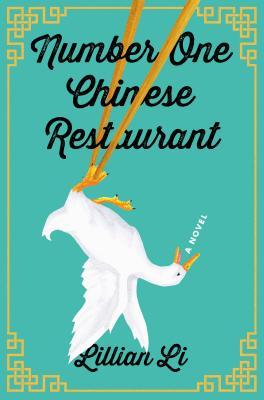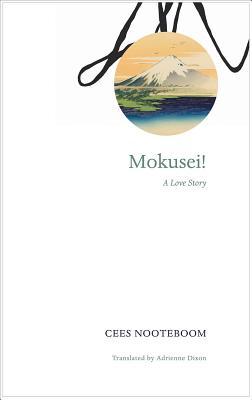#booksellers
This week, yet again, we lost ourselves in fiction. It’s is hard not to with so many brilliant titles, old and new, surrounding us. A couple of débuts, books announcing events we’re having in our stores, the 40th Anniversary edition of a hunting tale, and international titles are the picks we chose to share with you this week.
Number One Chinese Restaurant-Lillian Li
Upcoming Event at Politics and prose Saturday, June 23, 2018 - 6 p.m. to 7 p.m.

I am very biased toward Number One Chinese Restaurant for reasons that have nothing to do with the book itself. It’s a debut novel by a writer from the D.C. area—plus, her name is very close to mine. Usually, when I’m biased toward a novel for such silly reasons, it then disappoints me. Not this time! Number One Chinese Restaurant is a delight. Its food writing is as good as you want it to be, its characters are wonderful and wonderfully awful, and Li is expert at braiding together her high level of insight with her great sense of humor. Early in the book, one of her protagonists remembers ruefully, “Love came slowly, as weaknesses in the body often do.” As soon as I read that, I was sold. Lily M.
There There-Tommy Orange
Upcoming Event at Politics and Prose at The Wharf Monday, June 25, 2018 - 7 p.m. to 8 p.m.

Drawing his title from Gertrude Stein’s often misunderstood remark about Oakland, Orange in his tremendous debut novel wants “to bring something new to the vision of the Native experience” by presenting the untold and as yet unstereotyped “Urban Indian story.” He brilliantly accomplishes this in twelve interwoven profiles that tap into the “real passion…and rage” of Native Americans in contemporary Oakland. Powerful and moving, virtuoso narratives in There There bring us into the lives of children and grandparents, single mothers and drug thugs, recovering alcoholics and victims of abuse. All have complicated relationships with their heritage. Through these intimate and urgent stories Orange recovers the “there” of a Native history while also ending American Indians’ long struggle “to be recognized as a present-tense people, modern and relevant.” Laurie G.
The Changeling-Joy Williams

The night after finishing The Changeling, I had a nightmare so bad that I lashed out with my left foot while asleep and smashed my big toenail. Such is the degree that this book got under my skin. An inspiration for short story writers like Kelly Link and Karen Russell, The Changeling is essential reading on its own merits as a story about parenting, animals, the mundane and the starkly and horrifically transcendent. Adam Westcott
Convenience Store Woman-Sayaka Murata

Sayaka Murata’s Convenience Store Woman is both poignant and unsettling. It’s an intimate glimpse into an ordinary life that, in the eyes of society, is still not ordinary enough. This tiny book packs within a Kafkaesque look on conformity, questions about how to live one’s life and what it means to be ‘normal’, all with a fiercely feminist voice and sharp insight. Murata’s novel is the perfect entry point into contemporary Japanese literature. Anton B.
Mokusei!: A Love Story -Cees Nooteboom

This slim volume by the Dutch master begins with two Europeans in a cafe as they discuss the gap between how outsiders view Japan as a place of eastern mysticism and profound beauty and how it is in reality: a place bound to the same blandness and imperfections from which all places suffer. Mokusei is also a love story between a Dutch photographer and a Japanese model, whose relationship is doomed from the very beginning due to the insuperable gulf between the two cultures. It is a sign of Nooteboom’s mastery of his craft that he was able to create two different narratives and meld them into one cohesive whole. Bennard F.
Defending the Freedom to Read
Publishers, authors, and bookseller groups have joined the Unite Against Book Bans campaign

The American Library Association this week announced that more than 25 major organizations, including a host of publishers and author and bookseller groups, have joined its Unite Against Book Bans campaign, an effort to help communities defend the freedom to read.
Launched in April, the group aims to raise awareness about the surge in book bans and related legislation emerging around the country, reports Andrew Albanese, Publishers Weekly senior writer.
Among the groups declaring their support for the effort are the American Booksellers Association Free Expression Initiative, the American Federation of Teachers, as well as major publishers such as Macmillan, Penguin Random House, and Simon & Schuster.
“Awareness is a big part of the mission—but you’d have to be pretty out of the loop not to be aware of what’s going on here,” says Albanese.
“Awareness alone does not protect your freedom to read. This is one of those things where you need to show up—show up to your school board and library board and city council meetings, and get involved,” he tells CCC’s Chris Kenneally.
Listen Here
Nixon’s Favorite Sci-Fi: A Peak of the Genre During Turbulent Times

by Keith Roysdon
The period from 1968 to 1974 saw the release of more great science fiction films than any time before or since. The period coincided with one of the most turbulent times in United States history, from 1968 - the year of the assassinations of Martin Luther King Jr. and Robert Kennedy and the election of Richard Nixon - through Nixon’s resignation on Aug. 8, 1974. Those six years were the time of roiling protests and brutal police crackdowns, the Manson family’s murderous rampage, the Kent State massacre and escalation of the war in Vietnam. And the Watergate scandal that ended Nixon’s presidency.
The headline of this article is purposefully tongue-in-cheek, mainly because there’s little evidence that Nixon enjoyed or even saw many science fiction movies, a genre that had only recently grown past the 1950s atomic monster trend – yetI can’t think of the films of this era without thinking about them in the context of Nixon.
The essential list of films screened at the White House during Nixon’s time in office is What Nixon Saw and When He Saw It, compiled by Mark Feeney for his book, Nixon at the Movies. Pouring over the list of films screened at the White House, Camp David, San Clemente and other sites from January 1969 until the month before Nixon resigned shows that while the president liked movies and regularly screened a mix of classic and recent films for himself, his family and guests, few sci-fi movies were shown: Marooned, the 1969 film about astronauts stranded in space, Fail-Safe, the tense 1964 thriller about a president (Henry Fonda) trying to prevent nuclear war, The Omega Man, the 1971 after-the-end-of-the-world thriller starring Charlton Heston and On the Beach, the melancholy 1959 after-the-bomb film, shown at the White House about two months before Nixon was out of office.
The lack of scifi in Nixon’s taste feels funny in hindsight; I think some of the period’s science fiction films would have been Nixon favorites, had he seen them. If nothing else, *A Clockwork Orange would have reinforced his love of law and order.
READ MORE
When You Learn Your Mother Was a Serious Writer Only After She’s Gone
In March 2021, my mother, Nancy Bourne, a lifelong nonsmoker, died of lung cancer. Two weeks before that, though, as she cycled in and out of hospital wards, she was on her laptop sending off a flurry of query letters to literary agents asking for their help in selling her first novel. Six months before that she learned that another book of hers, a collection of short stories titled Spotswood, Virginia, would be published by a university press. In fact, in the last decade of her life she wrote dozens of short stories and published 35 of them.
But perhaps what’s most remarkable about my mother’s late-life literary renaissance is how few people knew about it. It wasn’t a secret, exactly. She belonged to two writing groups and took numerous creative writing classes and workshops. But outside a tight circle of family members and writing friends, she rarely talked about it.
READ MORE
Four times more male characters in literature than female, research suggests
A study by University of Southern California’s Viterbi School of Engineering used AI to measure pronoun use, uncovering a huge disparity in gender frequency

by Sarah Shaffi
Researchers using AI technologies have discovered that male characters are four times more prevalent in literature than female characters.
Mayank Kejriwal at the University of Southern California’s Viterbi School of Engineering was inspired by work on gender biases and his own work on natural language processing to carry out the experiment.
Kejriwal and fellow researcher Akarsh Nagaraj used data from 3,000 books that are part of the Gutenberg Project, across genres including adventure, science fiction, mystery and romance.
The study used Named Entity Recognition (NER) to identify gender-specific characters by looking at things including female and male pronouns. The researchers also examined how many female characters were main characters.
“Gender bias is very real, and when we see females four times less in literature, it has a subliminal impact on people consuming the culture,” said Kejriwal.
READ MORE
What bookstores and the literary life contribute to … life
A stack of new books illuminates the wonder of printed books — writing them, buying them, reading them

by Michael Dirda
Marius Kociejowski opens his enthralling memoir, “A Factotum in the Book Trade,” by observing that bookstores have begun to follow record stores into nonexistence. “With every shop that closes so, too, goes still more of the serendipity that feeds the human spirit.” While there may be “infinitely more choice” in buying from online dealers, “to be spoiled for choice extinguishes desire.” As he says, “I want dirt; I want chaos; I want, above all, mystery. I want to be able to step into a place and have the sense that there I’ll find a book, as yet unknown to me, which to some degree will change my life.”
An accomplished poet and beguiling essayist (try “The Pebble Chance”), Kociejowski has also enjoyed a long-standing career with various London antiquarian bookshops, starting with the once-venerable firm of Bertram Rota. Though a self-described “factotum” — which my dictionary defines as “an employee who does all kinds of work” — he nonetheless specialized in cataloguing modern first editions, once even handling books from James Joyce’s library. Over the years, Kociejowski came to be friends with poet and translator Christopher Middleton, travel writer Bruce Chatwin, “arguably the greatest prose stylist of his generation,” and the Spanish novelist Javier Marías, who as the reigning monarch of the joke Kingdom of Redonda, appointed him poet laureate in English of that tiny uninhabited island.
While authors can be colorful, book dealers are often notably cranky and eccentric. One conducting business in fashionable Cecil Court put up a sign that read, “Do not mistake courtesy on my part as an invitation to stay all day.” An independent book scout known only as Mr. Howlett invariably “wore an old, battered, greasy brown trilby all the year round, an aged raincoat in summer and a threadbare overcoat (two sizes too large) in winter.” What’s more, “he carried his ‘stock’ in a series of cardboard boxes,” these last secured with sisal twine until they fell apart.
READ MORE
IS BOOKTOK CHANGING THE WAY WE TALK ABOUT BOOKS?

by Addison Rizer
With Goodreads, BookTube, Bookstagram, and the #LitTwit community on Twitter, bookworms have been talking about books on social media for years. With BookTok’s recent emergence into the scene of bookish social media, especially with how impactful it has been on the sales of books both new and old, it got me wondering how the platform has changed the way we talk about books.
Do we use different terms for book recommendations or reviews than we did ten years ago? Do we ask for different types of books, or just ask differently? I decided to find out.
Before we can see any new trends in how we talk about and recommend books, first we’ve got to go back. To get a sense of how readers chatted about books before TikTok arrived, I went back to some BookTube channels you’ll probably recognize if you were in the community in its early years: PeruseProject and polandbananasBOOKS.
Looking back at their videos from eight and ten years ago, it’s fairly easy to see the similarities between their content at the time. Book hauls, wrap-ups, TBRs, tags, unhauls, and single-book reviews are the vast majority of what they posted. And they aren’t the only ones. If you look back at the early days videos of jessethereader or The Booktube Girl or abookutopia, you’ll see fairly similar content when they joined the community.
READ MORE
The War’s Toll on Ukrainian Publishers

An online survey of the Ukrainian book market undertaken by Anastasiia Zagorui on behalf of Ukrainian trade publication Chytomo was conducted from March 26 to April 8. Eighty-one publishers participated in the survey, which examines how the publishing community has adapted to wartime conditions; of those, 10% said they were forced to stop their operations, including 4mamas Publishing House, Abrykos, Booksha, DIPA, Mamino, Oleksandr Savchuk, Osnova Publishing Group, and Smoloskyp. Others, such as Blym-Blym, Ïzhak, and Klio, have been severely compromised. The majority of publishers, 51%, continue to publish but have altered their operating models, taking such measures as reducing their working hours. Thirty-nine percent of publishers had not changed their models when the survey was taken.
In one comment, the team of Creative Women Publishing said that, despite the war, they are back on track with all their projects. “Despite the fact that the publishing house’s employees are geographically dispersed—some have stayed in Ukraine and others are abroad—everyone keeps in touch,” Creative Women reported.
READ MORE
Best Fishes! Otis the cat, beloved employee at Loganberry Books, retires after 14 years
The great resignation shows no signs of paws-ing

by Kaylyn Hlavaty and Kristen Jantonio
CLEVELAND — Thousands of books immediately grab the attention of customers who walk into Loganberry Books on Larchmere Boulevard, but what is just as attention-grabbing is a four-legged feline named Otis who has been stealing the spotlight since 2008.
Otis, the well-known face of Loganberry Books, is retiring after 14 years of welcoming customers. His purr-sonality and love of litter-ature made him the perfect fit at this neighborhood bookstore.
A long and storied career in the bookstore business began when he showed up outside the home of Loganberry Books owner Harriet Logan. He was just a couple months old at the time, and as Logan tells it, he asked for a job and has worked there ever since.
READ MORE
 ALT
ALT ALT
ALT ALT
ALT“On March 5, 2007, a bomb went off in the centuries old Al Mutanabbi Street book sellers district in Baghdad. The explosion took the lives of thirty people and destroyed a large portion of the neighborhood. Al-Mutanabbi Street is named after the famous classical Arab poet Abu at-Tayyib al-Mutanabbi (915–965 CE), and it has been a thriving center of Baghdad’s bookselling and publishing for many years.
The book sellers, who survived, rebuilt their stores and are once again in business. They sell works by Sunnis, Shiites, Christians, and Jews, children’s books, and progressive publications from around the world.
A coalition of poets, artists, writers, printers, booksellers, and readers was created within a short time of the bombing; broadsides of their writings and artwork about this tragic event were printed, and recitations were made in many cities.
The 2007 bombing and the destruction of Al-Mutanabbi Street resulted Al-Mutanabbi Street Starts here – book arts and festivals to commemorate the bombing of Baghdad’s historic bookselling street and celebrate freedom of expression.” - Excerpts from Al-Mutanabbi Starts Here website.
Breathe for those who cannot.
Burrell, Ginger.
San Jose : Midnight Moon Press, c2013.
1 vol. ; 13 cm.
English
“Discarded book pages torn, burned and reassembled, original poetry by the artist."
Edition of 10.
Timothy Materer. Modernist Alchemy: Poetry and the Occult. Cornell Unversity Press, 1995. Hardcover. 218 pages.
Shop link in bio.
Kenneth Grant. Against the Light: A Nightside Narrative. London: Starfire Publishing Ltd., 2016. Standard hardcover edition. 124 pages.
Shop link in bio.
Michael Staley, editor. Starfire: A Journal of the New Aeon Volume II, Number 3. London: Starfire Publishing, 2008. Standard softbound edition. 189 pages.
Shop link in bio.
Shai Feraro. Women and Gender Issues in British Paganism, 1945-1990, Palgrave Historical Studies in Witchcraft and Magic. Palgrave Macmillan, 2020. Hardcover edition. 321 pages.
Shop link in bio.
Kenneth Grant. Gamaliel: The Diary of a Vampire & Dance, Doll, Dance! Starfire Publishing, 2003. Standard hardcover edition. 158 pages.
Shop link in bio.
Johannes Nefastos. Fosforos: Study on the Being & Essence of Satan and on the Occult Philosophy in Six Parts. Ixaxaar Occult Literature, 2013. Silk bound limited edition in custom slipcase. 225 pages. Limited to 145 copies (#17/145).
Shop link in bio.

